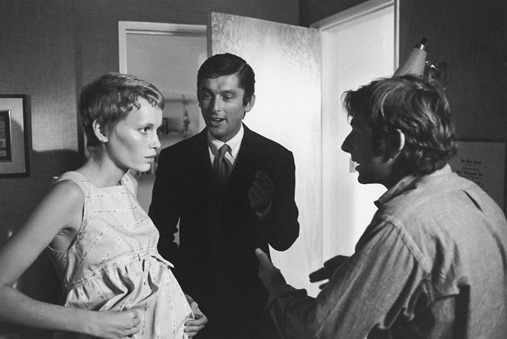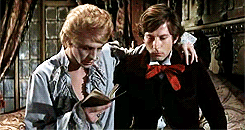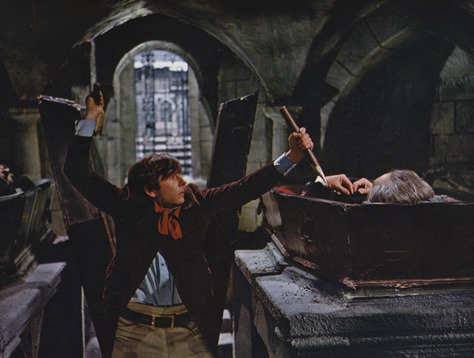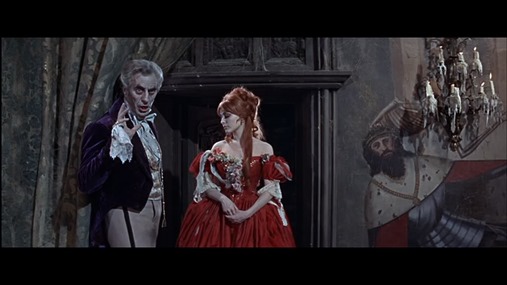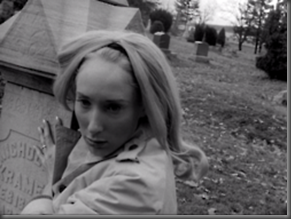I have seen a couple of them but I won’t comment on them because they are somebody else’s movie. That is really how I feel about it—they aren’t my movies anymore. I prefer it when they are the kind of remakes where the producers have to pay me money. That is the best kind of remake that there is.
Tag Archives: horror
‘Rosemary’s Baby’ – 1968
"Awful things happen in every apartment house."
The movie "Rosemary’s Baby", written for the screen and directed by Roman Polanski, from the novel by Ira Levin. John Cassavetes and Mia Farrow play a young couple who move into a new apartment, where they discover their neighbors are peculiarly friendly. Once Mia’s character becomes pregnant, she becomes paranoid over the safety of her unborn child. In true Polanski fashion, "Rosemary’s Baby" shows that even our loved ones could be working against us because human selfishness knows no boundaries.
In the mid 1960’s there was the “God is Dead” faction, a theological movement that surfaced in some academic circles and became a national controversy after a cover story in Time magazine.
Film Director Roman Polanski suffered the art inspiring real-life tragedy as his wife Sharon Tate was stabbed to death by the Manson Family while she was pregnant. The film’s composer died of a brain clot, similar to a character in the film’s predicament, just as soon as the film was done.
I don’t know about you, but I think it is included as one of the cursed movies of the century.
The Fearless Vampire Killers or: Pardon Me, But Your Teeth Are in My Neck
"That night, penetrating deep into the heart of Transylvania, Professor Abronsius was unaware that he was on the point of reaching the goal of his mysterious investigations."
Fearless Vampire Killers is what we may easily call a toothless affair, but it’s sort of charming in its own stupid way. Film is inspired by the aesthetics and mechanics of Hammer horror film, being a half tribute and half spoof of the classic British horror movies that came out of Hammer Studios in the 50s and 60s (they, again, were inspired by the even more classic Universal horror films of the 30s and 40s). Most of the slapstick is kind of awkward. It’s not really scary enough to be a proper tribute and it’s not really funny enough to be a spoof or comedy.
But I liked the castle. The castle, like all good spooky castles in horror movies, is more than an impressive set piece; it’s a character. The ersatz snow and faux-frost covering every (clearly soundstage) location gives the film a strange, phony atmosphere that sort of appealed to me too. Then there’s the awesome, bone-jangly musical score composed by Krzysztof Komeda. It feels like what it would have sounded like if Philip Glass had composed the music for Argento’s Suspiria (1977). There’s also a pretty good vampire ball towards the end. Vampires of all ages fancy regalia and dance in an elegant—albeit a bit dust-covered—ballroom. And they don’t actually kill a single vampire the entire film!
Amongst the ancestral portraits in the castle is a depiction of an ugly old woman inspired by a sketch of ‘Leonardo da Vinci’ and since the 18th century frequently connected with Margarete Maultasch, countess of Tyrol (1318-1369) and the murals in Count Krolock’s hall show motifs of Peter Brueghel the elder’s “Triumph of Death” (c. 1562).
For the ballroom scene (when the music stops and only three people are visible in a huge mirror despite of a few dozen vampires in the room) Roman Polanski had the room completely copied behind a fake mirror with three doubles acting as the human protagonists.
A musical adaptation of Dance of the Vampires premiered at the Raimund Theater in Vienna, Austria, on October 4, 1997. It was directed by Roman Polanski, and featured music by rock composer Jim Steinman, who is best known for his work with Meat Loaf and Bonnie Tyler.
Photos from the dance sequence.
And some devilish delights: Roman Polanski & Jack MacGowran on the set of The Fearless Vampire Killers.
Siegfried Kracauer, "Theory of film"
"We do not, and cannot, see actual horrors because they paralyze us with blinding fear; and that we shall know what they look like only by watching images of them which reproduce their true appearance. The images on the screen are a means to an end; they are to enable —or, by extension, induce— the spectator to behead the horror they mirror. The mirror reflections of horror beckon the spectator to take them in and thus incorporate into his memory the real face of things too dreadful to be beheld in reality. And this experience is liberating in as much as it removes a most powerful taboo. Perhaps Perseus’ greatest achievement was not to cut off Medusa’s head but to overcome his fears and look at its reflection in the shield. And was it not precisely this feat which permitted him to behead the monster?"
bruce kawin, “the mummy’s pool,” 1981
one goes to a horror film in order to have a nightmare—not simply a frightening dream, but a dream whose undercurrent of anxiety both presents and masks the desire to fulfill and be punished for conventionally or personally unacceptable impulses. this may be a matter of unconscious wish fulfillment, following freud; of confronting a hidden evil in the culture, as in ‘alien’ or ‘the stepford wives’; or of voyaging through the land of the dead and indulging a nostalgia for ritual […] horror films function as nightmares for the individual viewer, as diagnostic eruptions for repressive societies, and as exorcistic or transcendent pagan rituals for supposedly post-pagan cultures. they can be analyzed in all these ways because they represent a unique juncture of personal, social, and mythic structures and because each of these structures has a conscious/official and an unconscious/repressed dualism, whose dialectic finds expression in the act of masking.
Night of the Living Dead (1968), dir. George A. Romero.
Viy, Georgi Kropachyov and Konstantin Yershov (1967)
cabinet of dr. caligari silent film horror vintage 20’s 1920’s
Bela Lugosi
– It is women who bear the race in bloody agony. Suffering is a kind of horror. Blood is a kind of horror. Women are born with horror in their very bloodstream. It is a biological thing.
– Death, the final, triumphant lover.





